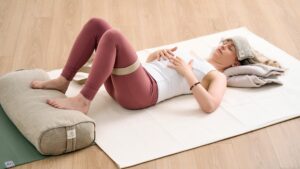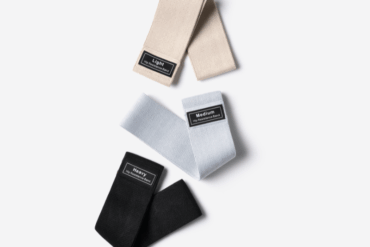As someone who sees themselves as an introverted extrovert, I can find myself struggling from time to time with social fatigue and sensory overwhelm. I find solace and rejuvenation in quietude and spending time alone, temporarily releasing myself from the need to engage with others and withdrawing my awareness inwards. This restorative yoga sequence offers just that, inviting a softening inward of the senses of perception and a quietening of the mind.
With a focus on creating support and a sense of ‘cradling’ around the head (including some light weight on the forehead with eye pillows), and a releasing of the body into gravity’s downward pull, I hope to encourage you into a deeply felt, non-verbal state which allows time and space for the thinking mind to soften.
Move through the whole sequence if you can or choose one of the poses below if you are shorter on time.
Effortless Rest Pose Variation
Lie on your back with your knees bent, feet raised onto the bolster and a folded blanket under the head. (Please see image for a specific fold of the blanket here, which folds the corners of the blanket inwards to create a cradling effect for the head). Use your belt around the thighs to help keep them hip-width. Allow the legs to rest out into the support of the strap. Adjust the shoulder blades down, and gently lengthen the tail towards the bolster to create length in the lower spine. Release the back of the body into the support of the floor, feeling gravity’s downward pull. Place the hands on the side ribs and begin to tune into the movement of the breath.
Tip: Make sure the bolster is on the sticky mat rather than the blanket, as this will prevent it from sliding away from you.
Duration: 5-20 minutes
Adho Mukha Jatthara Parivartanāsana/ Downward Facing Twist Pose
Place the bolster width-ways across the mat, with a foam block just beyond the bolster with the folded blanket on top. Sit side on to the bolster, with your knees softly bent and ankles crossed. Turn your torso down over the bolster, using the hands in the gap between the bolster and block to press the ground away and help you to rotate. Rest the torso downwards on the bolster and the forehead on the blanket on top of the foam block. Make sure the nose and mouth are free (not squished into the blanket) to allow space for the breath. Bend the elbows out to the side and rest the forearms on the floor, in what I call a ‘downward cactus’ position. Alternatively, you can fold one arm back over the bolster.
Duration: 5-7 minutes each side
Salamba Balāsana/ Supported Child’s Pose Variation
Pressing out of the Downward Facing Twist, sit back on the heels and fold the forearms over the wide bolster, supporting the forehead without squishing the nose and mouth. Option to use a folded blanket between the heels and sitbones here to lessen the bend in the knee and provide a soft texture. Notice how the darkening around the face here invites the perception to draw inward. Take a few slightly deeper breaths into the back of the body, feeling the back ribcage expand as you inhale, and softly release as you exhale. Then simple rest.
Duration: 2-5 minutes
Vīparita Karanī/ Legs up the Wall
Moving to a wall space, place the bolster a few inches away from the wall. Fold the blanket lengthways in what is referred to as an accordion fold (please see picture) and lay it perpendicular to the bolster, moving out from the centre. Perch on one end of the bolster with the hip that is closest to the wall lightly pressed up against it, so that you feel that side of the pelvis is in the gap between the wall and bolster. Then, taking the hands behind you on the floor, carefully swivel on your pelvis to take the legs up the wall. Settle the back of your shoulder blades, neck and head down, with the blanket running centrally along the back body. Make sure the back of the pelvis is fully supported on the bolster. Place the eye pillow on the forehead or over the eyes if that is comfortable.
Tip: If the hamstrings are on the tighter side, move the setup a bit further from the wall. Additionally, this can be practiced without the props by simply taking the legs up the wall with the back of the torso on the ground.
Duration: 5-20 minutes
Sūkhāsana Meditation with Elongated Exhalations
After Legs up the Wall, bend the knees so the soles of the feet are flat on the wall and gently push yourself back off of the bolster (if using). Roll to your side for a few breaths and gently bring yourself upright. Find a comfortable seated position. Sukhāsana is recommended here but you can sit however is comfortable. Raise the pelvis on to a block, blanket, or meditation cushion to allow for a tall spine.
Close the eyes and feel the weight of the pelvis releasing further down into the support beneath, while encouraging a soft length to move upwards through the centre of the torso. Soften the shoulders away from the ears, relax the face, and feel the arms hanging heavily by the sides with the palms resting on the knees or thighs. Begin to follow the natural pulsation of the breath. Inhaling, the breath flows in and down into the body, expanding outwards from the centre. Exhaling, the breath flows up and out, the body releasing back in towards the centre. Stay with this for a moment.
On the next inhalation, take a slightly deeper breath in, feeling the fullness at the peak of the in breath. Then, softly constricting the throat, exhale all of the air slowly out of the nose, emptying the breath. Pause at the end of the breath (if it is comfortable) and sense the stillness there. Then, as soon as you feel the natural impulse to inhale, allow the breath to flow in and repeat. Practice 3-5 breath cycles like this at a time, then breathe naturally for a few breaths before repeating.
Duration: 5-10 minutes
The post 5 Restorative Yoga Poses for Sensory Overload appeared first on Blog – Yogamatters.



